3 October- 23 December 2023
Enrico Baj
Imaginary Solutions
Enrico Baj
Imaginary Solutions
October 3rd – December 23rd, 2023
Galleria Gracis is delighted to announce that from October 3rd to December 23rd, 2023, it will host the exhibition “Imaginary Solutions”, dedicated to the great Milanese artist Enrico Baj on the 20th anniversary of his passing. As the heir to the surrealistic/dadaistic spirit, Baj experimented with unprecedented techniques and stylistic solutions throughout his career, using a diverse array of materials such as fabrics, medals, metallic fragments, beads, sequins, mirrors, and colored glass. His irreverent works, with subtle political implications, continue to express highly relevant themes.
The title of the exhibition refers to “Pataphysics,” coined by the French playwright and poet Alfred Jarry at the end of the 19th century, which greatly influenced Enrico Baj’s work. Pataphysics is essentially the reinvention of societal laws, overturning established codes, and the irony and irreverence of this science constitute, for Baj, “the antibodies of contemporary man against the oppression and homogenization of bureaucracy”. One can deduce that Baj’s work was precisely based on this assumption, with a consistently ironic yet extremely sharp interpretation of contemporary society.
From his early days with the Nuclear Movement, founded in 1951 as a response to the horrors of the Atomic Bomb, to his passionate portrayals of generals and ladies, figures where appearance prevails over essence and through which his anti-militaristic nature is evident, to the great masterpiece of the “Funeral of the Anarchist Pinelli,” social critique has been the driving force behind Baj’s artmaking.
An artist who has always been a fierce voice of dissent, and whose works remain highly relevant to this day, with their meaning growing stronger day by day. A poetic defined by Crispolti as “typically ironic-dissenting-farcical,” thus portraying a character/artist who looked at the world with the eyes of a child, engaging in a continuous play of assimilation and sarcastic, ironic reflection of reality.
On display is a series of works that illustrate the artist’s tendency to anthropomorphize reality. Baj’s systematic recovery of the portrait genre, however, strips the subject of any individuality and unique characteristics; it is emptied of all psychology to be adorned with medals, honors, and attributes of hollow significance. Grandiose names are assigned to ephemeral characters, whose importance lies solely in having been subjects of the portrait itself.
Just as in the Guermantes series, extensively represented in the exhibition with about 40 pieces, created by Baj from 1999 to 2000, inspired by the third volume of Marcel Proust’s “In Search of Lost Time.” Here, kings, queens, marquises, poets, dignitaries, artists, doctors, and generals parade, images of vanity.
Baj applies a multitude of imaginary solutions to his entire body of work, from drawings, paintings, and collages to mirrors, and even multiples, to which the artist dedicates himself passionately, seeking to democratize his art. He explores innovative modes of expression, resulting in variations of the concept of art in editions. Each artwork always appears unique, despite being produced in series, as Baj’s techniques do not allow for exact reproduction. In fact, each shell is inherently different from another, as is each cut of fabric or piece of trim, revealing his passion for meticulous craftsmanship and technical precision.
Even when Baj’s hand rests upon the mirrors, they do not reflect the existing, but, due to their fragmentary nature, they break down the reflected subject, transforming it into something grotesque and once again returning to the theme of portraiture. In works such as “Character at the Mirror”, in fact, one is both a spectator and a subject of the artwork simultaneously.
“Optimism and pessimism, in his eyes, must be counted among the profoundly comedic things. Dissatisfaction with the current state of affairs, social, political, scientific, acts as a stimulus for him. He creates his universe of sarcastic joy and iconoclasm thanks to this dissatisfaction, which never tends towards gloom, much less depression. A vast laughter, this is his personal response to the pervasive universal nihilism, and this laughter is felt in all his paintings.” (Alain Jouffroy, A Permanent Manifesto Against Stupidity)
Biography
Enrico Baj was born in Milan on October 31, 1924. A rebellious spirit opposed to all forms of militarism, he sought refuge in Geneva in 1944 to avoid military service. After the war, he attended the Brera Academy of Fine Arts (1945-1948) and studied Law at the University of Milan. Upon completing his studies at the Academy, in 1951, he co- founded the Nuclear Art Movement together with Sergio Dangelo and Gianni Dova and held his first solo exhibition at the San Fedele Gallery in his hometown. In 1953, he met Asger Jorn, with whom he founded the International Movement for an Imaginist Bauhaus, advocating against the forced rationalization and geometrization of art. The following year, he organized the International Meetings of Ceramics in Albisola, Liguria. From the 1950s, he became a prominent figure on the international art scene, regularly exhibiting in Paris and, from 1960, in the United States. In 1967, he began a long and fruitful collaboration with the Studio Marconi. André Breton invited him to exhibit with the surrealists in France, and in 1963, he dedicated an essay to Baj published in the magazine “L’oeil” by Rosamond and George Bernier.
In the 1970s, he received his first major retrospectives at Palazzo Reale in Milan, the Museum Boijmans van Beuningen in Rotterdam, and the Palais des Beaux-Arts in Brussels. His production is characterized by two main aspects: on one hand, a playful vein where the pleasure of creating art with various materials prevails, and on the other hand, a strong commitment to social issues and a critique of contemporaneity. This can be seen in his works from the 1960s, featuring Generals and Military Parades, and even more so in the works from the 1970s, such as ‘The Funeral of the Anarchist Pinelli’ (1972) and ‘The Apocalypse’ (1979). In the 1980s, he created the series ‘Metamorphoses and Metaphors’ (1988), in which he developed a figuration of the imaginary and the fantastic. In 1993, he began the cycle of ‘Tribal Masks’, assemblages made from the remnants of modern civilization, creating ironic and colorful masks, followed by the ‘Feltri’ (1993-98) and the ‘Totems’ (1997). The artist had numerous collaborations with Italian and foreign poets and writers, resulting in various artist books. He also collaborated with other artists, including Lucio Fontana and Piero Manzoni. In 2001, he started a series of works dedicated to the stories of Gilgamesh, the Sumerian king.
ENRICO BAJ
IMAGINARY SOLUTIONS
October 3rd – December 23rd, 2023
Opening: October 3rd from 10 a.m. to 9 p.m.
Galleria Gracis opening hours:
Monday-Friday, 10AM-1PM | 2-6PM
Saturday by appointment
Free entrance

